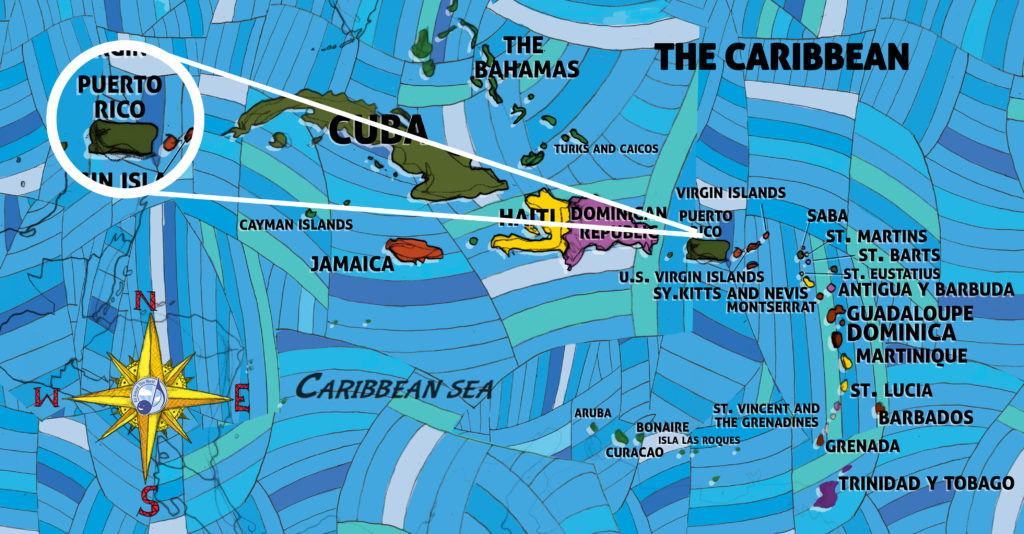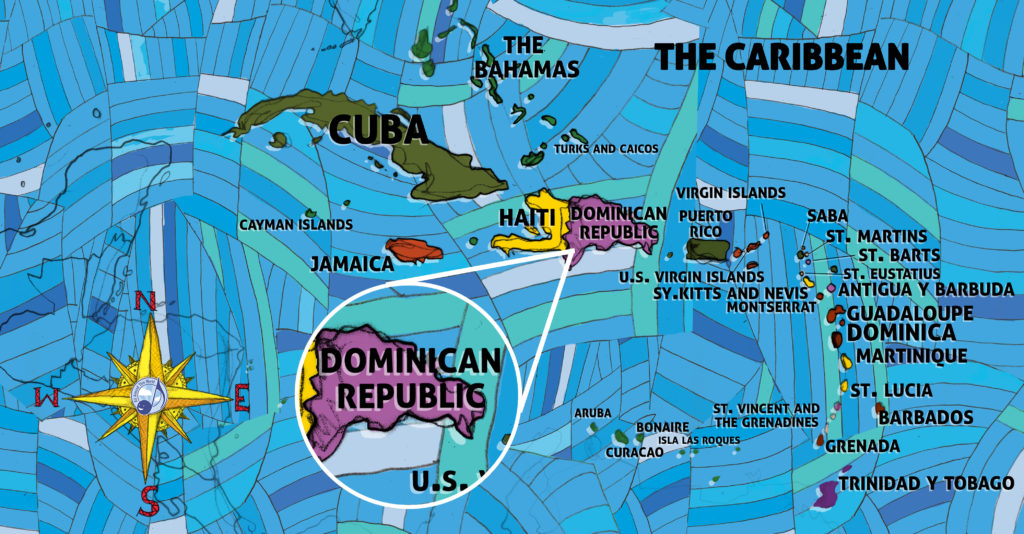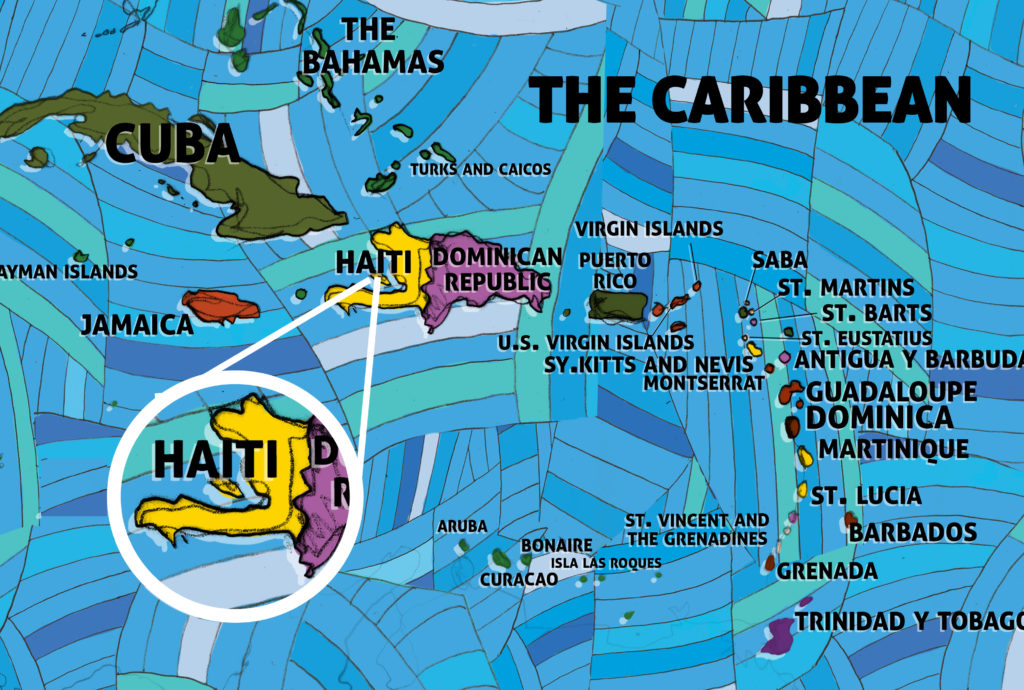
This week in our online class we sing and dance our way to Puerto Rico, a Caribbean island that has a long and complicated history of relationships with both Spain and the United States. In 1493 Christopher Columbus landed on Caribbean island now known as Puerto Rico, which the indigenous Taino called “Borinquen,” and declared it for the Spanish. Within fifty years the Spanish all but eradicated the Taino population, so they began to bring African slaves to the island to do hard labor. The island remained a Spanish colony, bolstered by the work of Africans, for four hundred years until the United States wrestled it away in 1898 during the Spanish-American War. Since 1898 the United States has controlled Puerto Rico’s government and economy, though not its culture. Currently Puerto Rico is a “Commonwealth” of the United States; the U.S. President is the formal chief of state but Puerto Ricans can’t vote in the presidential. Puerto Rico elects its own governor but it has no voting representation in the U.S. House or Senate.
The two-heads of the Tambora
A Dominican tambora is a bass drum that appears in various forms in various parts of Latin America but which is especially essential to merengue.
It is usually a double-headed drum, sometimes carried and sometimes fixed on a stand, sometimes with cymbals attached to provide for varying types of sound. The most traditional tamboras are converted rum barrels. The tambora in this video probably didn’t have a previous life as a rum barrel, though we have no cause to complain.
Johnny Ventura’s Patacon Pisao
Johnny Ventura, born as Juan de Dios, is a preeminent Dominican singer and band leader who Dominicans know for bringing American R&B and rock to merengue.
His greatest hit, which you’ll absolutely enjoy in this video, is an ode to the patacón, a flattened, fried green plaintain you’ll find in many Caribbean nations’ cuisine. Johnny Ventura is a popular musician to be sure, but he didn’t stop making friends with his tunes. From 1998 to 2002 Ventura was mayor of Santo Domingo, the DR’s capital and the largest city in the Caribbean.
Dreaming of the Dominican Republic

This week our All Around This World online class gets quite a treat — we visit the Dominican Republic. The “D.R.” is a nation that shares the island of Hispaniola with Haiti. Despite having its own challenge, when the Dominican Republic compares itself to the neighbor on its Western border–which it seems to do often– it is proud of its relative prosperity and stability. As we’ll find when we look at the history of the Dominican Republic, those things have come as the result of great struggle, much of it at the hands of the famed “Generalissimo,” Rafael Trujillo. Over the thirty years of his rule, Trujillo–known as “El Jefe”/”the Boss” –renamed the capital Ciudad Trujillo, erecting a huge neon sign that read Dios y Trujillo/”God and Trujillo”, required churches to post the slogan “Dios en cielo, Trujillo en tierra”/”God in Heaven, Trujillo on Earth” and eventually reversed the the order of the phrases, making it, “Trujillo on Earth, God in Heaven.” Today the Dominican Republic is known less for its dictatorial politics than for its beach resorts, merengue music (more about that through the week).
Haitian Rara Music — Bring your Vaksen the Rara
Haitian rara music is literally music of the street. And in rara, a vaksen is your friend.
Rara bands wielding drums, maracas and multiple hand percussion instruments take to the streets of Haiti in raucous public processions. These street celebrations are most prevalent during Easter week, but they also pop up during political campaigns to inspire enthusiasm for candidates. The vaksen is a long, cylindrical tube, a rousing, brazen trumpet . Whether you make your vaksen out of bamboo, as is tradition, or metal, or anything else, the most important thing is that your Haitian rara music is exuberant noise. Let the band in this video show you how.
The Frog is Hopping Hopping Hopping Krapo Tingele
“Krapo Tingele” is a Haitian folk song about a frog — a toad, actually, a “krapo” — and a horse who are in love with the same girl…of course!
And, doubly of course, they race to determine who can court her. In the All Around This World version the frog and horse actually try to one-up each other by attempting the other’s task; the horse tries to run, the frog tries to hop. What happens? Hilarity ensues. (Of course!)
Boukman Eksperyans takes us back to our Roots
Boukman Eksperyans is a Haitian “mizik rasin” (“roots music”) band that formed in the late ’70s when Lolo Beaubrun and his wife Mimerose joined a Haitian spiritual community (a “vodou lakou-s”) and founded a vodou-music study group called Moun Ife (“People of the Abode of the Deities”).
The band’s lyrics detailed the harsh living conditions in Haiti and called out the Haitian powers-that-be; its members fled the nation after the 1991 military coup overthrew Jean-Bertrand Aristide and lived in exile for many years. The name “Boukman” references Dutty Boukman, a Haitian vodou priest who is generally agreed to have started the Haitian revolution in 1791, and “Eksperyans” refers to the “Jimi Hendrix Experience.” This video gives us a good sense of both, and should definitely inspire us to want to learn more about Haitian music.
Haiti Will Survive

This week in our online class we will visit proud and resilient Haiti, a small country in the Caribbean with a rebellious streak and a terribly troubled past. This small former Spanish and then French colony, which shares an island called Hispaniola with the Dominican Republic, has a challenging history full of colonial manipulation, inspiring independence following an unprecedented slave rebellion (1791-1804), devastating environmental catastrophes, deep political failure, and, through it all, the ability of a resilient people to survive.
Conga and Carnival in Santiago de Cuba
Cuban conga music developed from rhythmic street parade performances by groups of musicians called comparsas which play music and dance in Cuban streets during festivals like Carnival.
The genre in the Western Cuban city of Havana is different from that of the Eastern city of Santiago de Cuba, which features a “Chinese horn.” SantiagoDeCubaCity.org says it like this: “I believe that there is not to have born for not feeling the contagious rhythm of La Conga, because still being dead, Oriental conga or Conga Santiaguera makes you resuscitate.”
¡Cubanismo! makes Mambo Even More Cool
¡Cubanismo! is a modern Cuban orchestra that celebrates Cuba’s deepest musical traditions, proudly performing compositions in Cuban genres like, “son,” rumba and chachachá.
They also play the ever-popular Mambo. In the 1930s, Cuban big band musicians added some elements of “son” to danzón to form a new up-tempo dance music. The mambo is based on the 3-2 clave and uses a 4/4 beat,with a dancer counting “quick quick slow,” moving his/her feet on the second beat of the four beat phrase, shifting weight to the other foot on the third, and returning to the original foot on the fourth. In other words, 1-2-3, 5-6-7. Mambo became most popular not in Cuba, but in Cuban refugee communities in New York and Mexico City. This video of a ¡Cubanismo! performance from the UK shows us that everyone can love it.

